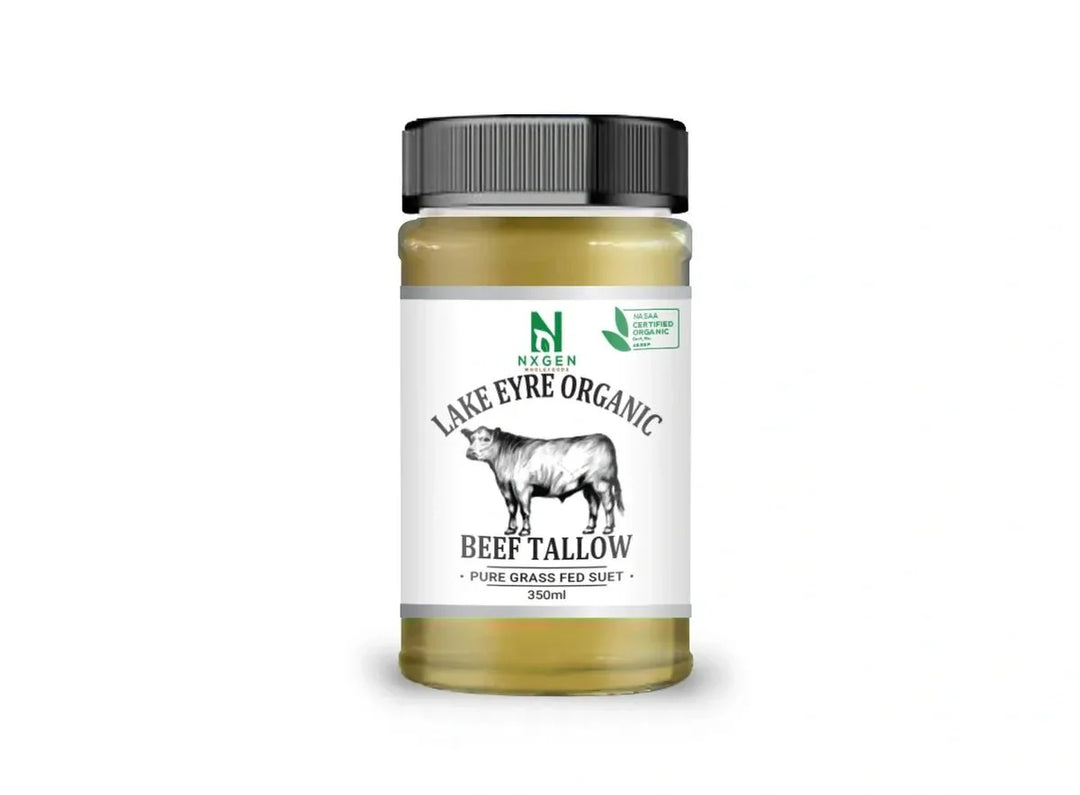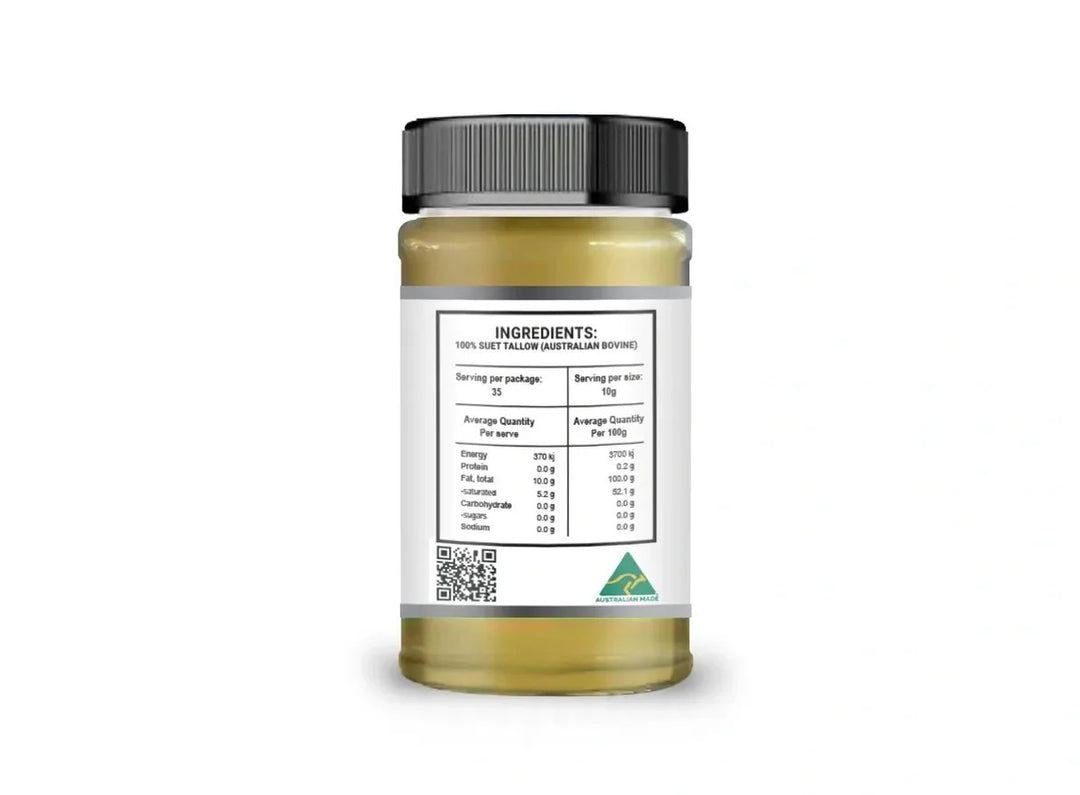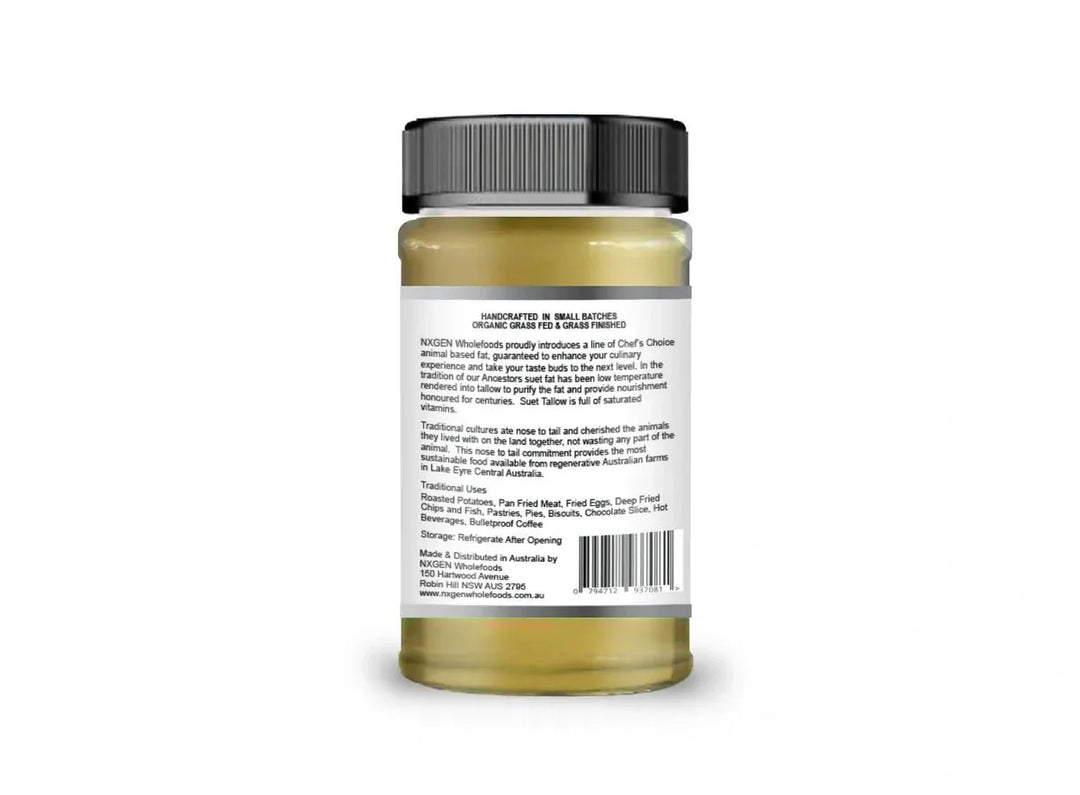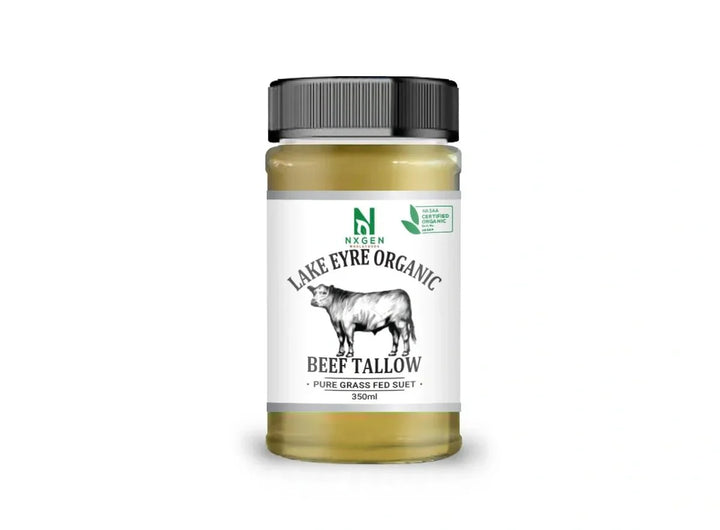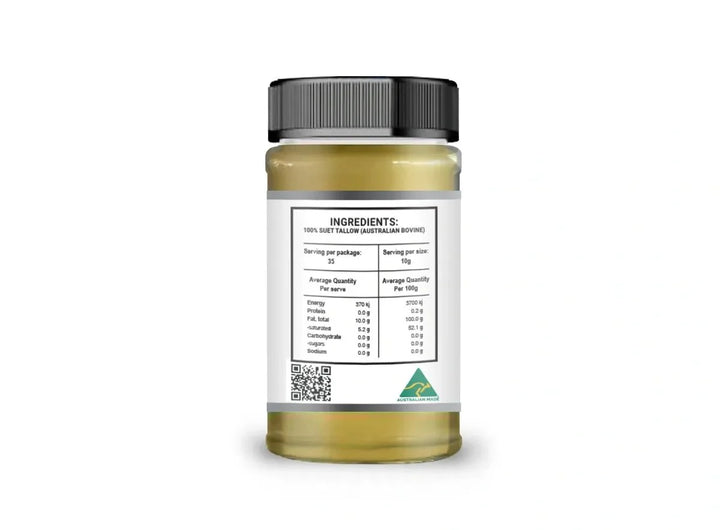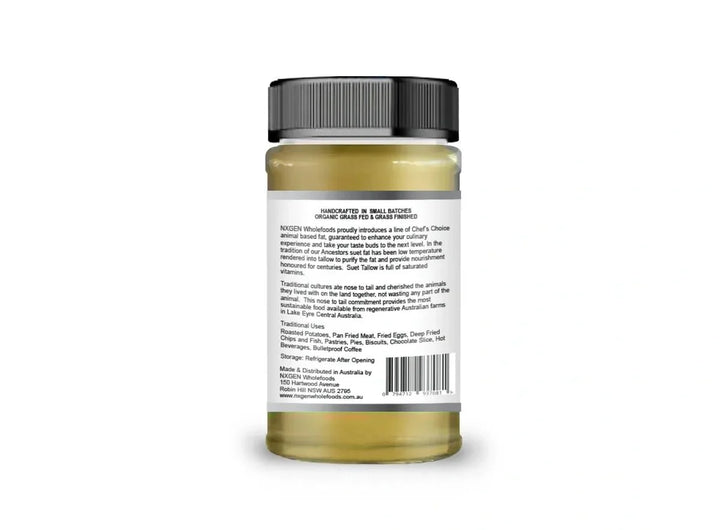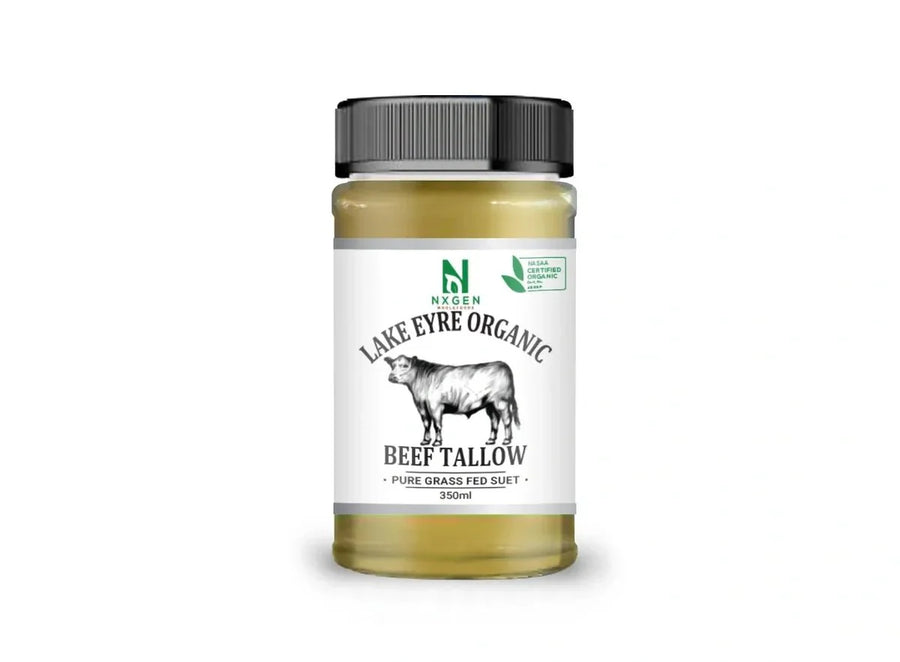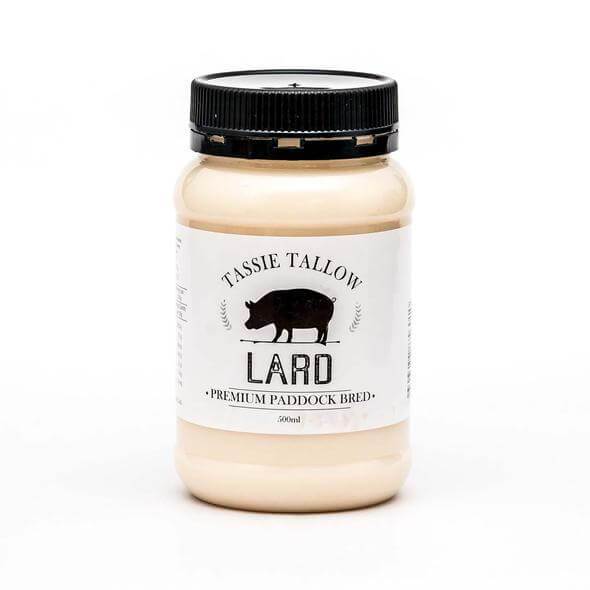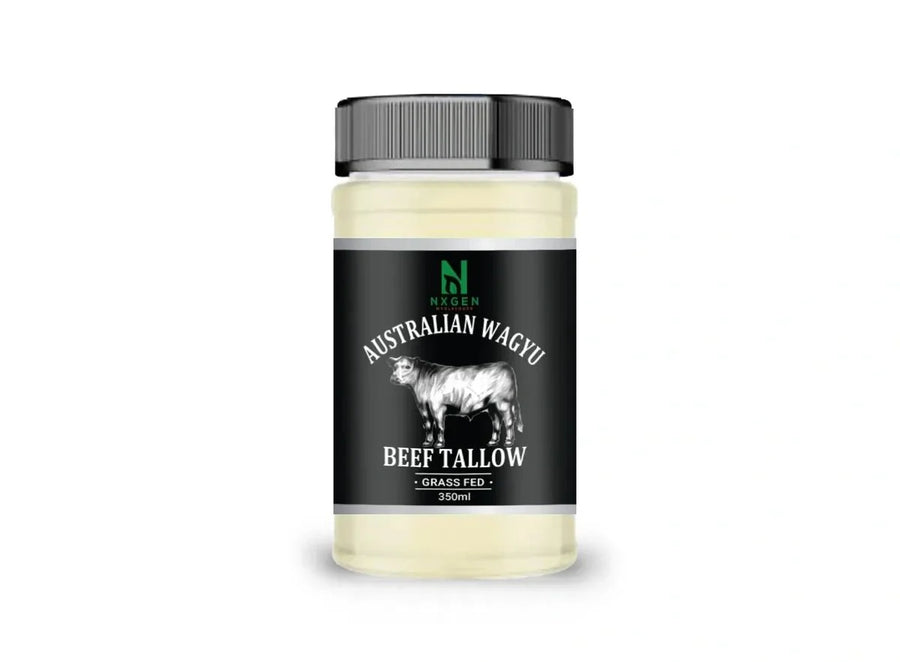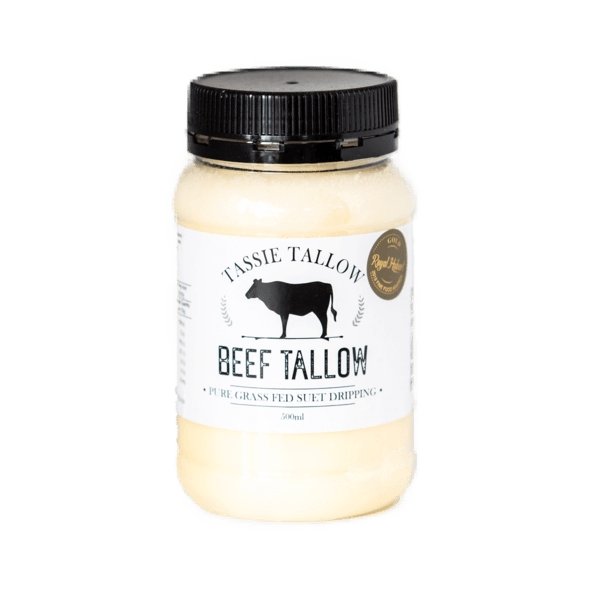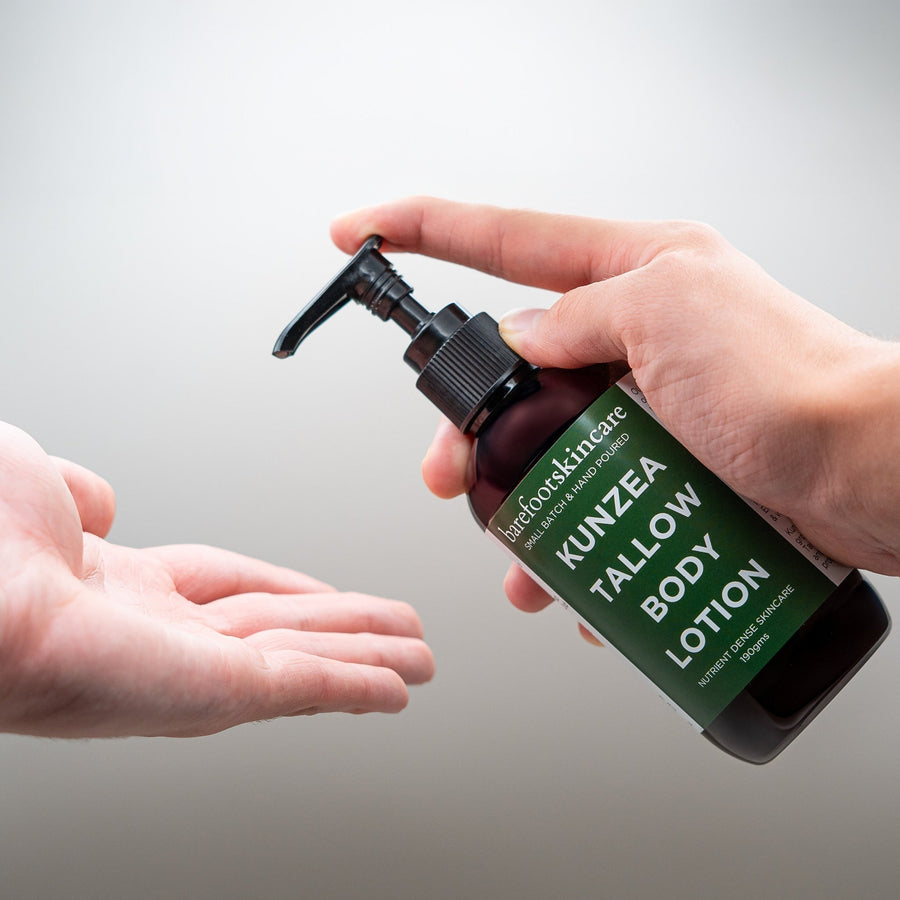Organic Beef Tallow is a nourishing superfood that can be used to treat a leaky gut and relieve joint pain. NXGEN Wholefoods tallow is 100% organic, grass fed, paleo and GAPS friendly. Ethically farmed with the highest animal welfare standards. It is ultra rich in the same kinds of lipids that are found naturally in youthful, healthy looking skin. Grass fed tallow also contains fat-soluble Vitamins A, D, E & K. All intrinsically balanced by nature, with no further improvement or enrichment needed.
Use for cooking in place of olive oil to
> Improve insulin sensitivity and mitochondrial fat-burning
> Improve weight loss
> Healthy body composition
> Increase your energy
> Improve exercise performance
> Better mood
Nutritional Properties
STEARIC ACID AND OLEIC ACID
These are both found in the protective outer layer of the skin and in sebum and have moisturising, softening, regenerative and anti-inflammatory properties. Stearic acid and Oleic Acid (Omega 9) improves skin’s suppleness and flexibility, aiding with skin damage and repair.
CLA (CONJUGATED LINOLENIC ACID)
Has anti-inflammatory and antimicrobial properties.
PALMITOLEIC ACID (OMEGA 7)
Is the most active anti-microbial found in our sebum. Palmitoleic acid is also a basic building block of our skin, but it’s production declines with age.
PALMITIC ACID
Aids with smoothing the appearance of skin and helps to improve barrier protection. It’s production in skin also declines with age.
AN OPTIMAL BALANCE OF ESSENTIAL FATTY ACIDS, ALPHA-LINOLENIC (OMEGA 3) AND LINOLEIC ACIDS (OMEGA 6), IN A RATIO OF ALMOST 1:1.
These essential fatty acids have a role in maintaining the structural integrity and barrier function of skin, they also influence inflammatory and immune responses in the skin.
VITAMINS A, D, E AND K
Fat soluble vitamins. All of which are particularly nurturing for the skin, and are only naturally found together in animal products.
Lake Eyre Beef is Organic Grass Fed & Finished sourced from regenerative farms in Central Australia. NXGEN Wholefoods beef cattle are free roaming and graze on over 240 native grasses from soil rich in vitamins and minerals. Organic Grass Fed means free of hormones, no antibiotics, no gluten, no dairy, no preservatives or additives, no GMO's, no chemicals such as glyphosate. 100% Tallow from Australian Suet Fat has been used for centuries. Unlike vegetable oils that break down at high cooking temperatures and that cause oxidative stress from free radicals NXGEN Wholefoods Beef Tallow has a high smoke point (>250C) and doesn't break down from heat, making it much healthier to cook with than vegetable oils.
Tallow is the finished product of rendered beef fat. It is a solid at room temperature and will keep for months when in a sealed container. Suet fat comes from around the kidneys and loins of the animal. Rendering involves melting the fat down at a low temperature (between 60 and 70C) slowly and clarifying it to remove any impurities, and moisture. Removing the moisture and impurities will ensure a longer shelf life of the tallow.
Tallow contains Vitamin D, E and Selenium along with saturated fat and conjugate linoleic acid (CLA) that are protective of our bodies. They help us to minimise any stress in the body.
The Case Against Vegetable Oils
Polyunsaturated oils from vegetable oils can amplify the stress response and have been linked to cancer, heart disease, premature ageing and more. Soy oil, cotton seed oil and sunflower oil are examples of polyunsaturated oils. Increasingly, more people are waking up, doing their own research and making conscious decisions for their health by choosing saturated fats, and returning to an Ancestral diet used by traditional cultures for centuries. A strong supporter of saturated fats is Australian Medical Doctor, Dr Ross Wilson.
Trans fatty acids are reported to be especially harmful to health. These fats come from hydrogenated vegetable oils via a chemical process, to form artificial trans fatty acids. The hydrogenation means that what were liquid vegetable oils (like soy, canola, sunflower) become solid/semi-solid at room temperature. Margarine is one such example. These are the fats that have had the worst press regarding their impacts on health. They have been linked to heart problems & cancer amongst other things, and you can easily search online to learn more about trans fatty acids.
Smoke point is the temperature at which the fat or oil starts to smoke in the pan. This is the result of the fat or oil breaking down. Vegetable oils will all oxidise naturally over time with exposure to oxygen and heat, sending them rancid and producing free radicals that cause destruction in the body.
This generally happens slowly – especially when stored correctly, but when these oils are heated (as in cooking) the oxidation reaction is sped up. When oils are cooked above their smoke point, free radicals are formed, so it’s important to use an oil or fat with a high smoke point when cooking at high temperatures.
Olive oil is a healthy choice that is best used on salads and breads, rather than being heated. Olive oil has a low smoke point so is best not used in stir fries or for cooking.
All the cells in our bodies have to communicate with each other and they do this by using proteins embedded into the cell membrane. The proteins are fixed to the cell membrane with the help of cholesterol and saturated fats! Fats therefore are essential for cellular health.
Each and every cell in the human body is made up of a lipid bilayer, known as the cell membrane, that should be stable and fluid if they contain the right substrates. That said, the lion's share of this bilayer should be made of "stable" saturated fatty acids for the cell to function properly; same holds true for our mitochondria. Unfortunately, other fat-like substances, such as trans fats, can get incorporated into cell membranes and wreak havoc, disrupting normal cell signalling. Thus, in the most basic sense, at the level of our cells and mitochondria, an incalculable number of saturated fat molecules are essential for life.
Beef Suet contains natural stearic acid (C18:0), which signals mitochondrial fusion, which makes mitochondria larger and more efficient, producing less free radical damage than when burning carbohydrates.
Polyunsaturated fats in Beef Suet provides DHA & EPA. DHA has important benefits in terms of biophysics and biology. There are numerous performative advantages to DHA, especially with regard to cognition, brain resilience and transport of the fat in blood triglycerides into cells for fat-burning (important for the heart muscle).
DHA represents about 97% of all omega-3 fatty acids in the brain,[28] and both EPA and DHA are essential for proper foetal development, including neuronal, retinal, and immune function.[29,30]. So, not only does obtaining ample EPA and DHA help stave off chronic inflammatory conditions and improve fertility, it also ensures you have the building blocks necessary for a healthy baby.
EPA and DHA are fundamental for shutting off inflammation and not letting it run wild.[22–24]. These effects are due to the fact that EPA and DHA serve as the precursors from which specific anti-inflammatory molecules are made.
Inflammation is known to play a role in many reproductive disorders,[25] not to mention obesity, diabetes, heart disease, and other health problems that have downstream negative effects on fertility. Infertile men have lower levels of EPA and DHA in their sperm than fertile men do,[26] and supplementation with EPA and DHA improves sperm quality.[27]
NXGEN Wholefoods embraces the philosophy of Ancestral Health used by traditional cultures for centuries for targeted support.
Organ meats were prized by traditional cultures more than muscle meats for vitality and healing. It’s the benefits of nose to tail eating that are missing from the modern diet that many people look for to provide targeted support "like heals like", adopting fundamental nourishment that governs our biology, health and well-being.
GRASS FED TALLOW CONTAINS:
- The Same Nourishing Fats That Our Early Ancestors Selectively Hunted For Robust Strength & Health
- The Matrix for Absorption & Assimilation of the Fat Soluble Activators (A, D, K & E); Supports Virtually Every Biological System
- Nourishing Fatty Acids: Conjugated Linoleic Acid (CLA), Arachidonic Acid (AA), Oleic Acid, Palmitic Acid, Alpha Linolenic Acid (ALA), Stearic Acid10
- Activators That Increase The Potency of CLA4
NOTE: The most common type of phospholipid contains one saturated fatty acid and one unsaturated fatty acid. The saturated fatty acids give the cell stability, while the unsaturated fatty acids provide flexibility.2This explains why without adequate saturated fat, cells become floppy, saggy... this goes for the cells you see (such as skin and gums) and cells you don't see (such as heart, brain and everything else).
GRASS FED TALLOW SUPPORTS:
- Fundamental Nourishment For Robust Strength, Health & Happiness [*2]
- Optimal Cellular Health Based On "Like Supports Like"[*2]
- Fertility & Hormone Health [*2]
- Inflammatory & Immune Health [*11,12]
- Growth & Development (healthy bones, teeth, gums and skin) [*13]
- Anticancer Effects [*14]
NOTE: A fatty acid is considered "saturated" when all available carbon bonds are occupied by hydrogen. These molecules are highly stable, which means that they do not normally go rancid, even when exposed to high heat for cooking.2
SUGGESTED USE
NXGEN Wholefoods Grass Fed Tallow is a Wholefood dietary supplement that provides 100% pure bovine tallow (from the prized suet). Add a quarter of teaspoon to a hot beverage for cream silky texture or take as directed by a healthcare professional.
BENEFITS
#1 Beef Tallow Contains Saturated Vitamins
The following four are present in beef tallow:
- Vitamin A: Tallow has more Vitamin A than muscle meat and bone marrow. Vitamin A is essential for cell differentiation, skin and eye health and immune system function
- Vitamin D: Plays a role in calcium absorption. Stimulates cells differentiation. Immune system health.
- Vitamin E: Potent antioxidant. Prevents LDL from getting oxidised. Vitamin E intake tends to be lower in Alzheimer’s patients .
- Vitamin K: Cofactor of binding to calcium, which helps prevent artery calcification. Activation of MGP which inhibits calcification. Increased Vitamin K intake is associated with lower rates of heart disease
- Many fatty acids, including palmitoleic acid, an antimicrobial fat, omega 3s and omega 6s.
#2 Beef Tallow May Increase Fat Burning
Paradoxically, eating more fat may increase how much fat you burn. Our body has two major hormones that regulate blood glucose and nutrient storage: Insulin and Glucagon. The two are antagonists. Insulin is a storage hormone. Glucagon is a nutrient mobilisation hormone. Ketosis occurs when Glucagon is high and Insulin is low. The high ratio between glucagon and insulin signals to your body to release nutrients from storage — i.e. body fat — and burn them for energy. Protein increases both insulin and glucagon secretion. Fat is the only macronutrient that only increases glucagon. Thus, if you want to burn more fat on the carnivore or keto diet, increasing, not decreasing your fat intake may be better.
Additionally, beef tallow is high in Conjugated Linoleic Acid (CLA). Conjugated linoleic acid is a fatty acid unique to ruminants.
In this meta-analysis of 18 studies, it was shown that CLA increased body fat loss.
#3 Beef Tallow is More Stable Than Other Cooking Fats
The fatty acid profile of beef tallow is 50% saturated fat, 42% monounsaturated fat and 4% polyunsaturated fat.
Saturated fatty acids are saturated with hydrogen atoms and only have single bonds. Whereas unsaturated fatty acids have multiple double bonds.
These double bonds make the fatty acids unstable. When the AHA — i.e. the mouthpiece for Procter & Gamble — brainwashed us into fearing saturated fats, we replaced them with these unsaturated seed oils such as Canola oil and Sunflower oil. This is one of the main vehicles that has driven our health off a cliff. And this was great for the big consumer companies. The seeds were traditionally a waste product, so they were cheap.
As a result, of the fear this created, soybean oil consumption increased 1000x in the 20th century. Linoleic acid now is 8% of calories
What are the consequences of this shift? Well, you are what you eat.
Between 1959 and 2008, Linoleic Acid in human fat tissues increased by 136% . In this meta-analysis, the average concentration of linoleic acid in human fat tissue was 25%. People are walking canola oil bottles. Because of the double bonds, these fatty acids are very unstable. When you cook with seed oils you blast your food with cancer causing radicals. The scarier part is that even at body temperature linoleic acid can oxidize and cause free radicals . So if your body fat is composed of linoleic acid, you’re basically a microwave causing radioactive destruction internally. Free radicals and the toxic breakdown products of Linoleic acid like HNE are implicated in almost every disease pathology. Vegetable oils have been linked to all of the following diseases:
- Alzheimer’s
- Cancer
- Insulin resistance
- Acne
- Heart disease
- Autism
- Dementia
- Heart disease
- Autoimmune disorders
- Leaky gut
Most importantly, it turns out that the bad cholesterol, “LDL”, is only bad when it’s damaged by unsaturated fats.
Beef tallow on the other hand has very high oxidative and thermal stability.
#4. Tallow is Affordable
Beef tallow is highly affordable and easy to make at home. Eating more fat will also cut down your protein intake and help you spend less.
#5. CLA May Protect against Breast Tumors and Colon Cancer
The CLA in beef tallow may protect against metastatic breast tumors.Animal studies consistently show that CLA reduces mammary tumor metastasis. Relatively low levels of CLA are required for mice to experience these benefits.
#6. Saturated Fat May Be Good for You
Saturated fat may have longevity increasing benefits. Some stem from the stability discussed above. But there are many more too.
For instance, people in Hong Kong consume 695 grams per day of meat. At that rate, you’d expect them to be practically rolling down the street and dropping like fleas from heart disease. But they actually have the world’s longest life expectancy at 84.5 years .
This study pictured below depicted similar results. Saturated fat intake is negatively correlated to heart disease in Europe.
This can be explained a number of ways:
- Increased saturated fat intake tends to reduce carbohydrate consumption, which really causes heart disease
- Saturated fats tend to be higher in fat-soluble nutrients, Vitamins A, D, E and K. Increased Vitamin K intake is associated with lower rates of heart disease [*]
- Reduced vegetable oil consumption
- Half of the fat in your brain is saturated. It is indispensable to cognitive function.
- Caprylic acid, a saturated fat, strengthens the immune system [*]
- Palmitoleic acid is highly anti-viral and anti-bacterial.
- Saturated fats help build hormones [*]
- Cell membranes are 50% saturated fat
- Saturated fats increase HDL, the “good cholesterol”
- Scientists have now realised LDL particle size matters more than total LDL number. Diets high in saturated fat and low in carbs increase LDL size (which is a positive) [*]
- High fat diets leads to ketosis and reduces oxidative stress and inflammation.
- Because saturated fats don’t have double bonds, they’re more resistant to oxidative damage [*]
- Saturated fats have a glycemic index of 0
Lastly, studies continue to debunk the myth that saturated fat causes heart disease. This review from 2014 looking at 76 studies, found no link at all between saturated fat and heart disease .
#7 Tallow May Benefit Your Skin
It’s commonly suspected that eating a fatty diet will clog your pores and make you look like a pubescent teenager. That’s not the case in my experience. Our cell membranes are made up of fatty acids. They are ~50% saturated fat. Tallow’s make up is almost identical, which nourishes cell membranes and keep your skin moisturised. Sebum, the oily substance that moisturises and protects the skin actually translates to tallow in latin. They are very similar in makeup with both being comprised of triglycerides. The more fat, the better my skin. A few more explanations:
- High-fat diets can reduce inflammation
- Higher fat diets reduce insulin, which is implicated in acne
- CLA is antiviral, antimicrobial and anti-inflammatory
- Vitamin D and Vitamin E are antioxidants
#8. Tallow is Tasty
Beef tallow has a delicious taste, and it adds a lot of flavour to food.
It’s not a coincidence either. Your body craves the nutrients and fats. That’s why it tastes so good.
#9. Tallow is “Sustainable”
Not to pile on with the sustainability buzzword, but tallow is much better for the environment than vegetable oils.
The production of certain vegetable oils, like palm oil, leads to widespread deforestation and a high carbon footprint. Whereas tallow from locally raised, grass fed beef can actually be carbon negative. Additionally, butchers often throw away tallow (which is absolutely crazy if you ask me…it’s like throwing gold in the dumpster). You can ask many of them for their fat trimmings (get them before they are in the dumpster) and turn them into tallow.
Sources and References
- https://books.google.com/books?id=jxsR83VZc84C
- https://books.google.com/books?id=WB85DwAAQBAJ&pg
- www.westonaprice.org/health-topics/traditional-diets/guts-and-grease-the-diet-of-native-americans/
- https://www.manataka.org/page2200.html
- www.westonaprice.org/health-topics/know-your-fats/some-recent-studies-on-fats/
- www.westonaprice.org/health-topics/know-your-fats/the-skinny-on-fats/
- Fishman, Stanley A. "The Benefits of Organ Meats." Tender Grassfed Meat. N.p., 09 Dec. 2014. Web. 17 June 2017.
- https://en.wikipedia.org/wiki/Pemmican
- "Spleen, 500mg, 180 Capsules." Dr. Ron's Ultra-Pure. N.p., n.d. Web. 17 June 2017.
- www.westonaprice.org/health-topics/know-your-fats/fatty-acid-analysis-of-grass-fed-and-grain-fed-beef-tallow/
- https://www.ncbi.nlm.nih.gov/pubmed/15674307
- https://www.ncbi.nlm.nih.gov/pubmed/15159257
- http://gutenberg.net.au/ebooks02/0200251h.html
- https://academic.oup.com/jn/article/136/1/88/4664179
- http://www.whitewolfpack.com/2013/08/elders-talk-about-significance-of-long.html
16. https://www.westonaprice.org/health-topics/know-your-fats/some-recent-studies-on-fats/
17. 27. Hosseini, B. et al. The Effect of Omega-3 Fatty Acids, EPA, and/or DHA on Male Infertility: A Systematic Review and Meta-analysis. J. Diet. Suppl. 1–12 (2018).
18. 28. Greenberg, J. A., Bell, S. J. & Van Ausdal, W. Omega-3 Fatty Acid supplementation during pregnancy. Rev. Obstet. Gynecol. 1, 162–169 (2008).
19. 29. Swanson, D., Block, R. & Mousa, S. A. Omega-3 fatty acids EPA and DHA: health benefits throughout life. Adv. Nutr. 3, 1–7 (2012).
How to Use: Scoop a spoonful into our roasting or frying pan, the high melting point makes it absolutely perfect fat for deep frying and roasting. Beef Tallow can be stored up to a year in an airtight container.
FDA STATEMENT*Any statements made on this website have not been evaluated by the Australian Therapeutic Goods Administration (TGA) or Food and Drug Administration (FDA). Product information and statements made are not intended to diagnose, prevent, treat or cure any disease.
Reference:
- Cynthia A Daley, Amber Abbott and Stephanie Larson (2010) A Review of Fatty Acid Profiles and Antioxidant Content in Grass Fed and Grain Fed Beef.
https://www.ncbi.nlm.nih.gov/pmc/articles/PMC2846864/ - Costanzo A, Russell CG, Lewin S, Keast R. A Fatty Acid Mouth Rinse Decreases Self-Reported Hunger and Increases Self-Reported Fullness in Healthy Australian Adults: A Randomized Cross-Over Trial. Nutrients [Internet]. 2020 Mar 2 [cited 2020 Mar 9];12(3):678. Available from: https://www.mdpi.com/2072-6643/12/3/678
- Fallon, S. 2001. Nourishing Traditions. New Trends Publishing. Washington.
- Stewart JE, Feinle-Bisset C, Golding M, Delahunty C, Clifton PM, Keast RSJ. Oral sensitivity to fatty acids, food consumption and BMI in human subjects. Br J Nutr. 2010 Jul;104(1):145–52.
- Mattes RD. Is There a Fatty Acid Taste? Annu Rev Nutr [Internet]. 2009 Aug 22 [cited 2020 Feb 29];29(1):305–27. Available from: http://www.annualreviews.org/doi/10.1146/annurev-nutr-080508-141108
- USDA. Nutr Food Sci [Internet]. 2012; Available from: https://www.nutritionvalue.org/Beef%2C_raw%2C_suet%2C_variety_meats_and_by-products_nutritional_value.html
- Innis SM. Palmitic Acid in Early Human Development. Crit Rev Food Sci Nutr [Internet]. 2016 Sep 9 [cited 2020 Nov 24];56(12):1952–9. Available from: https://www.tandfonline.com/doi/abs/10.1080/10408398.2015.1018045
- Tutunchi H, Saghafi‐Asl M, Ostadrahimi A. A systematic review of the effects of oleoylethanolamide, a high‐affinity endogenous ligand of PPAR‐α, on the management and prevention of obesity. Clin Exp Pharmacol Physiol [Internet]. 2020 Apr [cited 2020 Nov 25];47(4):543–52. Available from: https://onlinelibrary.wiley.com/doi/abs/10.1111/1440-1681.13238
- Fuke G, Laerte Nornberg J, Laerte Nornberg J. Systematic evaluation on the effectiveness of conjugated linoleic acid in human health. Crit Rev Food Sci Nutr [Internet]. 2017 [cited 2020 Nov 25];57(1):1–7. Available from: https://www.tandfonline.com/action/journalInformation?journalCode=bfsn20
- Whigham LD, Watras AC, Schoeller DA. Efficacy of conjugated linoleic acid for reducing fat mass: A meta-analysis in humans. Am J Clin Nutr. 2007 May 1;85(5):1203–11.
- Karakaya S, Ebnem S¸, Ims¸ekims¸ek S¸. Changes in Total Polar Compounds, Peroxide Value, Total Phenols and Antioxidant Activity of Various Oils Used in Deep Fat Frying.
- Dumelin EE. The Environmental Impact of Palm Oil and Other Vegetable Oils **.




